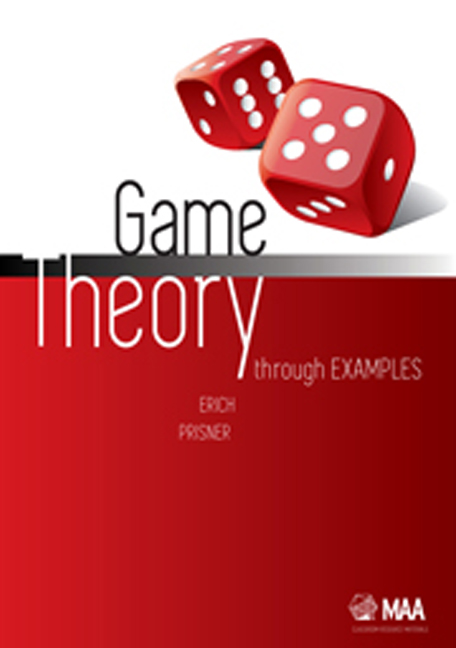Book contents
- Frontmatter
- Contents
- Preface
- 1 Theory 1: Introduction
- 2 Theory 2: Simultaneous Games
- 3 Example: Selecting a Class
- 4 Example: Doctor Location Games
- 5 Example: Restaurant Location Games
- 6 Using Excel
- 7 Example: Election I
- 8 Theory 3: Sequential Games I: Perfect Information and no Randomness
- 9 Example: Dividing A Few Items I
- 10 Example: Shubik Auction I
- 11 Example: Sequential Doctor and Restaurant Location
- 12 Theory 4: Probability
- 13 France 1654
- 14 Example: DMA Soccer I
- 15 Example: Dividing A Few Items II
- 16 Theory 5: Sequential Games with Randomness
- 17 Example: Sequential Quiz Show I
- 18 Las Vegas 1962
- 19 Example: Mini Blackjack and Card Counting
- 20 Example: Duel
- 21 Santa Monica in the 50s
- 22 Theory 6: Extensive Form of General Games
- 23 Example: Shubik Auction II
- 24 Theory 7: Normal Form and Strategies
- 25 Example: VNM POKER and KUHN POKER
- 26 Example: Waiting for Mr. Perfect
- 27 Theory 8: Mixed Strategies
- 28 Princeton in 1950
- 29 Example: Airport Shuttle
- 30 Example: Election II
- 31 Example: VNM POKER(2, r, m, n)
- 32 Theory 9: Behavioral Strategies
- 33 Example: Multiple-Round Chicken
- 34 Example: DMA Soccer II
- 35 Example: Sequential Quiz Show II
- 36 Example: VNM POKER(4, 4, 3, 5)
- 37 Example: KUHN POKER(3, 4, 2, 3)
- 38 Example: End-of-Semester Poker Tournament
- 39 Stockholm 1994
- Bibliography
- Index
33 - Example: Multiple-Round Chicken
- Frontmatter
- Contents
- Preface
- 1 Theory 1: Introduction
- 2 Theory 2: Simultaneous Games
- 3 Example: Selecting a Class
- 4 Example: Doctor Location Games
- 5 Example: Restaurant Location Games
- 6 Using Excel
- 7 Example: Election I
- 8 Theory 3: Sequential Games I: Perfect Information and no Randomness
- 9 Example: Dividing A Few Items I
- 10 Example: Shubik Auction I
- 11 Example: Sequential Doctor and Restaurant Location
- 12 Theory 4: Probability
- 13 France 1654
- 14 Example: DMA Soccer I
- 15 Example: Dividing A Few Items II
- 16 Theory 5: Sequential Games with Randomness
- 17 Example: Sequential Quiz Show I
- 18 Las Vegas 1962
- 19 Example: Mini Blackjack and Card Counting
- 20 Example: Duel
- 21 Santa Monica in the 50s
- 22 Theory 6: Extensive Form of General Games
- 23 Example: Shubik Auction II
- 24 Theory 7: Normal Form and Strategies
- 25 Example: VNM POKER and KUHN POKER
- 26 Example: Waiting for Mr. Perfect
- 27 Theory 8: Mixed Strategies
- 28 Princeton in 1950
- 29 Example: Airport Shuttle
- 30 Example: Election II
- 31 Example: VNM POKER(2, r, m, n)
- 32 Theory 9: Behavioral Strategies
- 33 Example: Multiple-Round Chicken
- 34 Example: DMA Soccer II
- 35 Example: Sequential Quiz Show II
- 36 Example: VNM POKER(4, 4, 3, 5)
- 37 Example: KUHN POKER(3, 4, 2, 3)
- 38 Example: End-of-Semester Poker Tournament
- 39 Stockholm 1994
- Bibliography
- Index
Summary
Prerequisites: Chapters 12, 22, 24, 27, and 32.
In October 1962, US surveillance discovered that the USSR was about to install offensive atomic missiles in Cuba. For one week President John F. Kennedy and his advisors kept the knowledge secret and discussed what to do. It has been reported that in these meetings the Secretary of Defense, Robert McNamara, outlined three options: trying to solve the problem politically, continuing the surveillance and starting a blockade, or undertaking military action against Cuba. A week after the discovery, when it released information about the crisis, the US announced it would undertake a blockade, which it called a “quarantine”. As Russian ships continued to steam toward the blockade, many around the world thought that the US and USSR (and hence all nations) would slip into an atomic war. After several days of blockade, letters between Kennedy and Soviet Leader Nikita Khrushchev, and diplomacy behind the scenes, the conflict was resolved. The Soviets removed their offensive missiles from Cuba.
Although “game” doesn't seem appropriate for a crisis as serious and threatening as this one, game theory and in particular the game of CHICKEN is often used to model the Cuban missile crisis. In CHICKEN both parties move simultaneously, move only once, and have just two options: to stand firm, the Hawk move, or to give in, the Dove move. If both stand firm, a nuclear war is unavoidable. As far as the payoffs are concerned, at that time, 1962, it was obvious that a nuclear war would be by far the worst possible outcome for both parties. Both giving in does not change things much, but if one gives in and the other remains firm, the firm party has a slight advantage, both for achieving its goal, and raising its stature in public opinion.
- Type
- Chapter
- Information
- Game Theory Through Examples , pp. 237 - 243Publisher: Mathematical Association of AmericaPrint publication year: 2014

